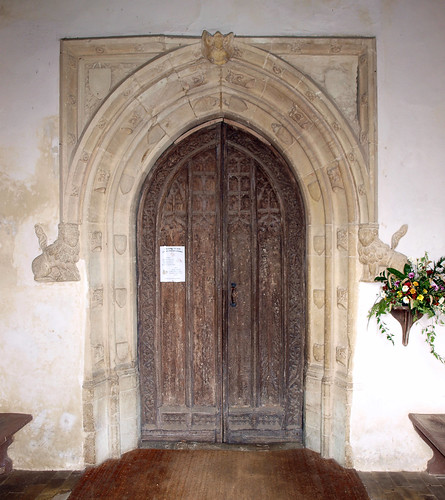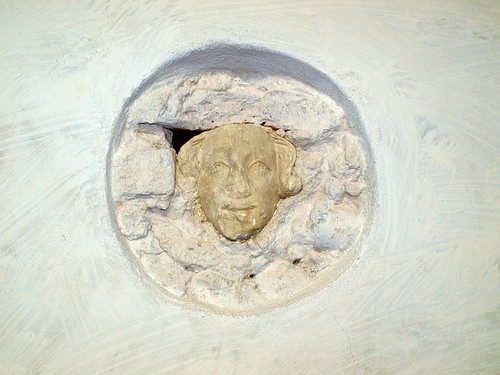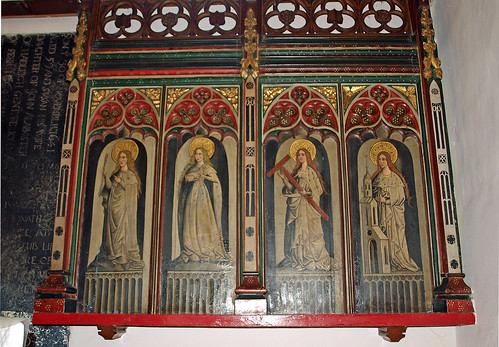A large building remote from the village which I found, perhaps because of repairs subsequent to the tower collapse, to be soulless which is a shame because it has several elements that should make it grand but the sum of the whole is disappointing.
ST MARY. The church is on a hill outside the village. Dec chancel with inventive five-light E window. Dec N aisle E window with reticulated tracery. Tall Perp W tower. The W doorway big with three niches over. Large Perp aisle windows with segmental arches. Clerestory with twice as many windows as bays of the arcade. S porch with flushwork, entrance with fleuron decoration. The S doorway is excellently decorated with crowns, shields, etc. Hood-mould on seated lions. Spandrels with shields. The arcade of five bays has piers with four filleted shafts and small spurs without capitals in the diagonals. The abaci have rows of small busts or leaf motifs. Many-moulded arches. No chancel arch. Roof with alternating tie-beams and hammerbeams. - FONT. Octagonal, Perp. Damaged stem. Bowl with the four Signs of the Evangelists and four demi-angels. - Wooden BALCONY from the upper storey of the porch to the aisle. - COMMUNION RAIL. Slim turned balusters. - STALLS with simple MISERICORDS, heads, etc., all defaced. - STAINED GLASS. E window by Wailes & Strang, 1874 (TK). Scenes only in the tracery heads. - One S window by Kempe, 1892. Typical of his early work. - PLATE. Elizabethan Cup; Paten of 1639; Cup of 1780. - BRASS. William Wade d. 1599 and wife (wearing a hat).
BILDESTON. One of Suffolk’s pleasant little towns, it has some fine old timbered buildings and was once famous for its cloth and blankets. Its church away on a hill is surprisingly big and lofty, and is mostly 500 years old, though the lower part of the tower is a century older still. There is a mass dial. Much carving the church has in wood and stone, a doorway with lions, crowns, and an angel, a beautiful old door with tracery and birds, a huge old font with angels and symbols of the Evangelists and tiny battered human figures, and lofty arcades with men and women and angels. The old altar rails are gracefully turned, and near by are some old stalls with poppyheads still fine, though the carvings on their tip-up seats are badly damaged. An attractive south porch has a room above leading to a little wooden gallery in the nave.
Here in brass are portraits of Alice Wade and her children, wearing the clothes in which they came to worship in Shakespeare’s day. Alice has a brocaded petticoat, the sons are in cloaks and ruffs, and the daughters are wearing high hats. More exciting for its memories is the stone to Captain Edward Rotherham, who sleeps outside, where the wind blows over him as it blew through the rigging of his ship. He was with Lord Howe in the victory of the famous First of June; and was in command of the Royal Sovereign at Trafalgar, well and truly doing the duty England expected of him.
Here in brass are portraits of Alice Wade and her children, wearing the clothes in which they came to worship in Shakespeare’s day. Alice has a brocaded petticoat, the sons are in cloaks and ruffs, and the daughters are wearing high hats. More exciting for its memories is the stone to Captain Edward Rotherham, who sleeps outside, where the wind blows over him as it blew through the rigging of his ship. He was with Lord Howe in the victory of the famous First of June; and was in command of the Royal Sovereign at Trafalgar, well and truly doing the duty England expected of him.



No comments:
Post a Comment